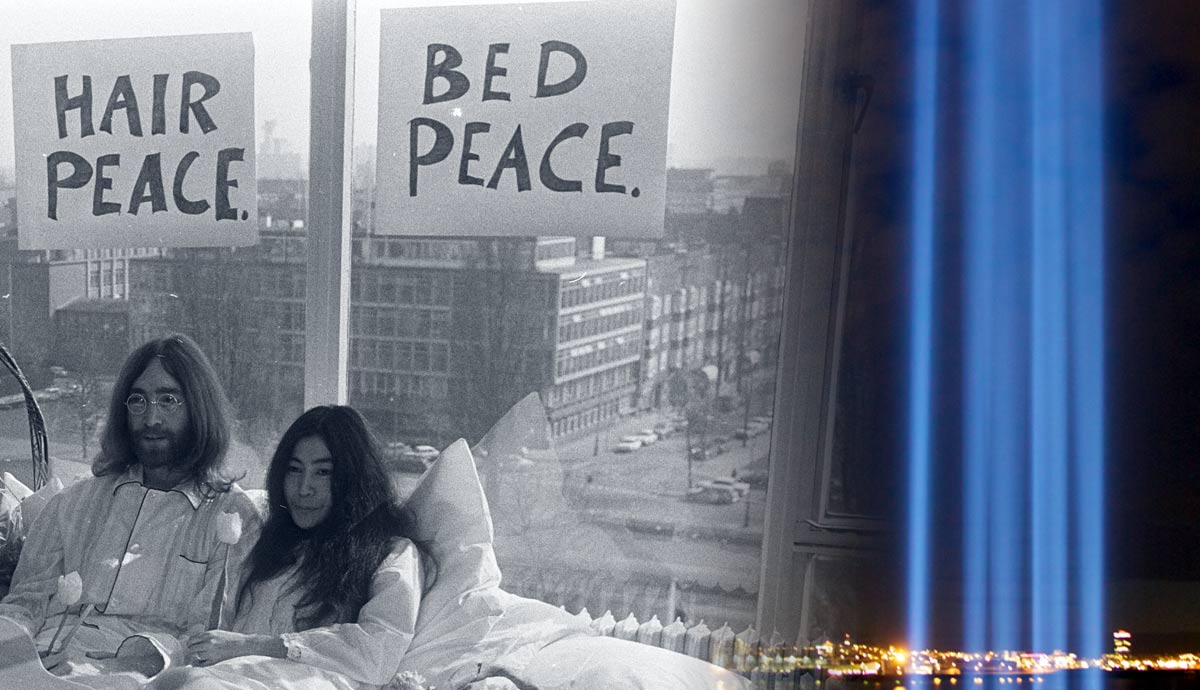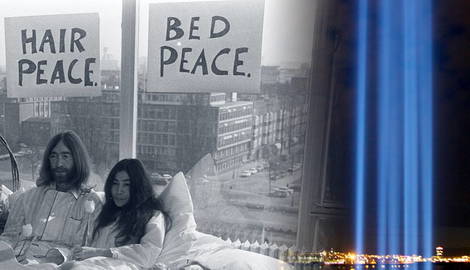
While the press has often reduced her to her role as John Lennon’s wife, Yoko Ono was in fact way more radical than her rockstar-husband. When they met in the 1960s, she had already been pushing the boundaries of art for several years. However, it has taken the public a long time to start embracing Ono´s artistic work. Today, she is known as one of the most important contemporary performance artists.
What Type of Art Did Yoko Ono Make?

Experimental music, performance art, installation art, participatory art, activism, conceptual art, and video art—Yoko Ono has had her hands in pretty much everything, making this versatile woman one of the most interesting figures in today’s art world. Apart from being a prominent member of the Fluxus movement, she has also been heavily involved in promoting ideas related to world peace. She also co-created several chart-topping hits. In this article, we will introduce you to ten artworks by this extraordinary artist.
1. Cut Piece (1964)

The performance Cut Piece started with Yoko Ono sitting on a stage, fully clothed. The audience received instructions to come and cut off any piece of clothing they liked. As the audience members snipped away at her clothes, her body became more and more exposed. By turning the spectator into an active participant, Yoko Ono subverted the relationship between the audience and the artist. She also raised questions about power, the female body, as well as its objectification.
2. Grapefruit: A Book of Instructions and Drawings (1964)

In 1964 Yoko Ono published a book called Grapefruit. This work consisted of sets of instructions for art and life which were both humorous and absurd. However, the intent behind them was clear. Yoko Ono was inviting the reader to treat their own life as a piece of art. This way she blurred the lines between art and life.
3. Wish Tree (1966-)

Yoko Ono´s artworks usually involve a degree of audience participation, and Wish Tree is no exception. The idea behind this artwork was simple. Yoko Ono planted a tree in a museum and asked people to write their wishes on a piece of paper and tie them to one of the branches. Ono has created this installation in various cities across the world. As time goes on, the trees and the number of wishes tied to them continue to grow, making Ono’s wish trees a symbol of collective hope.
4. Arising (2013)

Arising is yet another participatory installation that Yoko Ono has set up in various galleries. Once again, the idea was as simple as it was powerful. Ono asked women who had experience with abuse to send in their stories about oppression, along with a photograph of their eyes. These testimonies would then become part of a large installation. The artwork also pays homage to victims of violence through a pile of burned bodies placed on the floor. By inviting women to share their stories, Yoko not only draws attention to the suffering experienced by millions of women but also empowers women across the world to stop hiding their pain.
5. Bed Sit-In

While some people blame Yoko Ono for breaking up the Beatles, one could also say that her refreshing attitude served as a fountain of inspiration and hope for a disillusioned John Lennon. Soon after they got together, the couple started creating experimental music and performance art. For one thing, they decided to spend their honeymoon engaging in a Bed-Sit-In For Peace, during which they allowed the press into their bedroom for 12 hours a day. It was their way of making a public statement against the war in Vietnam, while also breaking down conservative conventions of the time. Their Bed-Sit-In was just one of the many ways in which they mixed art, activism, and life. They also co-wrote the song Imagine in 1971, although Yoko only received her co-writing credit in 2017.
6. Rape (1969)

In 1969, Yoko Ono and John Lennon released a film called Rape. The experimental film is 77 minutes long and shows a woman being followed by a camera crew. In the beginning, the woman’s reaction is one of surprise and annoyance, but as the film progresses, she starts to break down. While the film does not show any physical violence, it plays with the question of privacy, the power of the camera lens, and the complex dynamic between the subject and the object. This powerful conceptual film also brings up topics like the objectification of women, surveillance, and the loss of privacy experienced by celebrities.
7. Bottoms (1966)

A few years before releasing Rape, Yoko Ono released a short film called Piece No.4 (Bottoms). As the title suggests, the film shows only one thing—the bottoms of different people. By zooming in on one area of the human body only, Yoko Ono playfully asks the viewer to see this intimate part in a new way.
8. Museum of Modern (F)Art (1971)

Yoko Ono certainly has a sense of humor and loves playing with the expectations of her audience. In 1971, she put an ad in the newspaper, inviting people to a one-woman show at the Museum of Modern (F)art. When people arrived at the Museum of Modern Art, there was no Yoko Ono show to be found. Instead, a sign informed the visitors: THIS IS NOT HERE. To make things even more sarcastic, visitors were then asked how they found out about the show. Like many other artists of the 20th and 21st centuries, Yoko Ono started questioning expectations around art, and how these were linked to existing power structures. In the case of Museum of Modern (F)art, the non-existing exhibition was the actual artwork.
9. Imagine Peace Tower (2017)

The Imagine Peace Tower is an open-air light installation in Iceland, consisting of a beam of light reaching far into the sky. Yoko Ono created it to commemorate John Lennon, and it is lit at specific times and dates throughout the year. As part of the project, Yoko Ono also asks people across the world to send in their wishes. People can do so via e-mail and social media, or they can just think of a wish. The project was unveiled in 2017 and is ongoing.
10. My Mommy Is Beautiful (Ongoing)

As of February 2023, Yoko Ono is 90 years old. And while she has become part of the establishment, she continues to be ahead of her time. As the Imagine Peace Tower Project shows, she has started experimenting with participatory artworks in the realm of social media. My Mommy is Beautiful is yet another crowdsourced art piece that uses the internet to bring people together. To create the art piece, Yoko has asked people across the world to upload pictures of their mother using the hashtag #mymommyisbeautiful. The artist also encourages people to add a love note, poem, or personal message. She also promises to use the pictures and messages submitted by contributors in an exhibition that is yet to be revealed.
Yoko Ono: Always Breaking Boundaries

Given the fact that Yoko Ono´s work is highly experimental and some of her music numbers consist of primal screams, one might be surprised to learn that she has also recorded several number-one hits. However, Yoko Ono serves as a real-life example that everything is possible. There is probably no other artist who has managed to put themselves into the midst of popular culture while remaining truly avant-garde in the same way as Yoko Ono.
Throughout her life, Ono has struggled with both lack of recognition and the strains of stardom. But no matter whether people ignore, praise, or criticize her, it seems that the artist has developed the ability to stay true to her identity. By creating a body of work that features various mediums and genres, Ono has refused to put herself into a box. She has also placed herself in the unique position of promoting peace and love in her art, without avoiding the pain and darkness of life. Yoko Ono is a maverick, whose unapologetic approach to art and life has placed her in a position that is both strongly unique and charmingly relatable. And while it is impossible to predict what Ono will be up to next, one thing is for sure, she is going to continue surprising us for as long as she’s alive.










